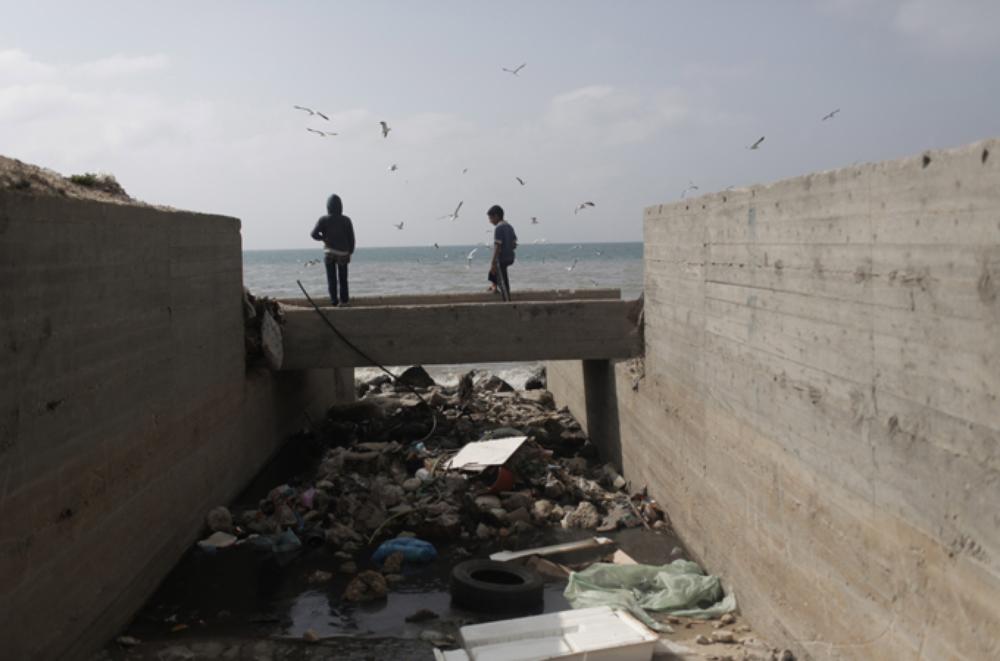Image

Source
Nassar, Wissam. 2014. “In Pictures: Gaza Water Crisis Worsens.” Al Jazeera. May 12, 2014. https://www.aljazeera.com/indepth/inpictures/2014/03/pictures-gaza-water-crisis-wors-201432673053211982.html
Tolan, Sandy. 2018. “Gaza’s drinking water spurs blue baby syndrome, serious illness.” Al Jazeera. October 29, 2018. https://www.aljazeera.com/indepth/features/gaza-drinking-water-spurs-blue-baby-syndrome-illnesses-181029110434881.html
Language
English
Contributor(s)
English

Substantive Caption: This image comes from a series of photographs by Gaza based photographer Wissam Nassar for Al Jazeera published in May of 2014. One of ten images in the photo essay, Nassar captures the Mediterranean sea from behind the silhouettes of two young appearing boys standing atop a sewage drainage structure. The boys appear to be looking off into the grey sea waters as seagulls fill the sky above them. Just beneath them, and in immediate view of photograph, the viewer’s vision of the sea is obstructed by the toxic debris, trash, plastics, and other contaminants pulled through the drainage structures out into the Mediterranean. Beneath the image reads the caption, “More than 30 percent of households in Gaza only have access to running water for six to eight hours, once every four days” (2014, Nassar). Accompanying the photo series is a short article outlining the “Gaza water crisis” and its worsening conditions.
Design Statement: I selected this visual of toxicity captured by Gaza photographer Wissam Nassar for the following reasons:
The image captures the simplicities of youth and joy in the wake of visible toxicity, degeneration, and contamination.
Given the geographical specificity, the occupied Palestinian territory of the Gaza Strip, the image reveals a specific context out of which toxicity emerges.
Toxicity must be examined as a utility of militarization and occupation.
Situated as part of a journalistic photo essay, the image invites an multi-sited ethnography where the image along with text make legible otherwise discarded social worlds.
Gaza is often discussed in terms of Israeli bombings, targeted killings, and other spectacular forms of violence. This image, however, a mundane toxicity and a banal violence.
Captured and published in 2014, Wissam Nassar’s photo essay, “In Pictures: Gaza Water Crisis Worsens” reveals Gaza’s other war: a war of human degeneration. This particular image, while not spectacular in any significant way, captures a mundane toxicity reflective of Palestinian life. Two young boys stand atop a concrete beam connecting two sides of a sewage drain. They, like many other folks, are perhaps drawn in by the calming ripples of the sea in their distance. On the left, a young hooded boy stares out into the distance, his back to the audience. Rather, his gaze is fixed on the waters of the Mediterranean sea in front of him. To his right, another boy-perhaps a friend, relative, sibling- has his right foot propped up on the beam’s edge, with his left foot is firmly planted on the lower surface of the concrete slab. His gaze is shifted closer to where they stand, to what is directly beneath them. The calming sea waters appear to be hitting against large boulders creating small waves. Whether in the distance or crashing up against the boulders, the sea offers the boys a leisurely moment, perhaps one of joy.
While the sea appears to be commanding the full attention of the boys, the viewer’s attention is hijacked by the toxic debris, trash, plastics, and other contaminants front and center of Nassar’s photograph. The boys are situated above the toxins spilling out from the sewage drainage site, we, however, the viewers, are immediately confronted by the accumulation of contamination. The toxicity at this drainage site reflects systems of degeneration that have become central to Israel’s control over Palestinian life (and death) in the Gaza Strip. And, this toxicity is captured here by Nassar as the banal backdrop of the photograph. Various accounts have highlighted Gaza’s ongoing suffering due to cataclysmic water shortages, run down sewage facilities debilitated by a decade-long Israeli-Egyptian blockade and Israel’s repeated bombing of water and sewage infrastructures, and harmful salt, nitrate, and chloride levels in water sources. According to the short article linked to Nassar’s photo, “90 percent of Gaza’s main water supply is unfit for drinking, and unsuitable even for agricultural use” (2014, Nassar). Here, we are challenged with the banality of toxicity. Water, a source of life and sustenance, has become a utility of power. The inability to access and adequately treat water produces a condition of toxicity that emanates beyond the frame of Nassar’s image. The logics of militarization and occupation require toxicity to leak into all aspects of life. The debris and trash accumulated and visually caught by Nassar’s lens are just reminders of the systems of degeneration forced onto Palestinians in Gaza (and elsewhere). Children, like those pictured here have become at risk of water borne diseases such as gastroenteritis, kidney disease, paediatric cancer, marasmus and "blue baby syndrome" (2018, Tolan). Thus, in capturing the two children entranced by the sea, Nassar offers up an alternative to Palestinian sociality otherwise degraded by toxicity.